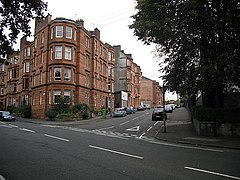Maryhill
Maryhill
|
|
|---|---|
 Shakespeare Street |
|
| Maryhill shown within Glasgow | |
| OS grid reference | NS563691 |
| Council area | |
| Lieutenancy area | |
| Country | Scotland |
| Sovereign state | United Kingdom |
| Post town | GLASGOW |
| Postcode district | G20 |
| Dialling code | 0141 |
| Police | Scottish |
| Fire | Scottish |
| Ambulance | Scottish |
| EU Parliament | Scotland |
| UK Parliament | |
| Scottish Parliament | |
Maryhill (Scots: Maryhull, Scottish Gaelic: Cnoc Mhoire) is an area of the City of Glasgow in Scotland. Maryhill is a former burgh. Maryhill stretches over 7 miles (11 km) along Maryhill Road. Several sub-districts belong to the Maryhill district, such as Acre, Dawsholm Park, Firhill, Gairbraid, Gilshochill, Maryhill Park, North Kelvinside, Queen's Cross, St George's Cross, Cadder (Glasgow), Summerston, Woodside and Wyndford.
The far north west of the area is served by Maryhill railway station.
Hew Hill, the Laird, or Lord, of Gairbraid, had no male heir and so he left his estate to his daughter, Mary Hill (1730-1809). She married Robert Graham of Dawsholm in 1763, but they had no income from trade or commerce and had to make what they could from the estate. They founded coalmines on the estate but they proved to be wet and unprofitable, and their property ventures are best known for an acre of ground they did not sell. It is still known as Acre today.
No doubt they would have continued with the struggle, but on 8 March 1768 Parliament approved the cutting of the Forth and Clyde Canal through their estate, which provided some much-needed money. The canal reached the estate in 1775, but the canal company had run out of money and work stopped for eight years. The Government granted funds from forfeited Jacobite estates to start it again and the crossing of the River Kelvin became the focus for massive construction activity. Five locks, the great Kelvin Aqueduct and, between two of the locks, a dry dock boatyard were built. A village too began to grow up and the Grahams fed more land for its development; Robert Graham attached one condition that was to immortalise the heiress of Gairbraid, his beloved wife and the last in line of centuries of Hills of Gairbraid after the death of her father Hew Hill. The then village was to be "in all times called the town of MaryHill".
...
Wikipedia

